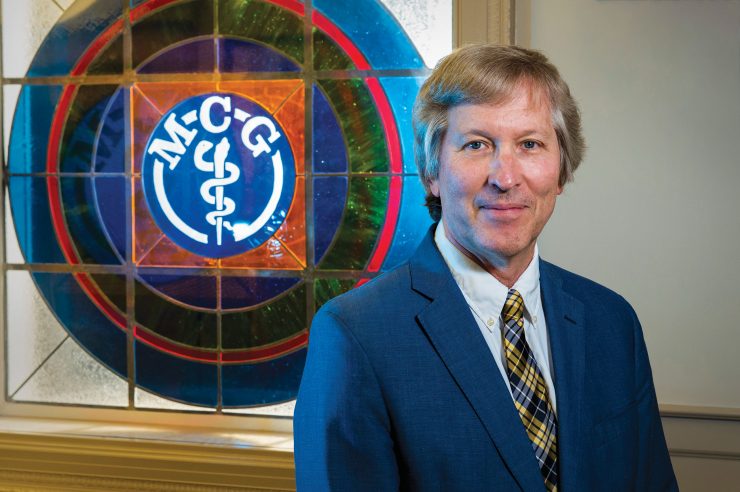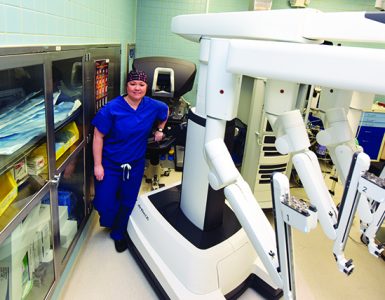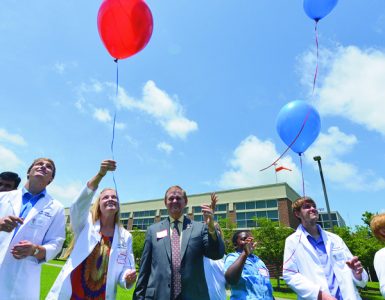You are what we are known for. If you travel Georgia, the Southeast, the nation and beyond, people in the know about medical education know that the Medical College of Georgia is exceptional at educating physicians. The best residency programs want our students, communities want our graduates, and we sure want to keep our students as residents and our graduates as faculty. Educating great physicians is our core, and we just graduated our 185th class. So when you have a time-tested method, do you try to make it even better? The best physicians, you our graduates, have lifelong learning in your DNA so I know your answer would be yes.
The 3+ curriculum at MCG, which began with our Class of 2024, was the most significant change in our significant history. One year in, it’s still a work in progress but I believe it is work that will benefit both your medical school and the state we are privileged to serve. We call our new curriculum tailor-made medical education because it gives our students four excellent pathways to choose from. Succinctly put, it offers an expedited three-year medical degree for those who choose to do their primary care training in Georgia, the idea here is to enable more students to select primary care by enabling them to get to know the people and health care needs of our state even better and by reducing financial pressure to make a more lucrative specialty choice when your heart is in frontline care.
Thanks to our first major supporter, Peach State Health Plan, along with matching funds included in this year’s budget from the state of Georgia, we have established an endowment that will provide scholarship support for these students — a year of scholarship support for each year they commit to serve in Georgia’s most medically underserved areas — to ensure that the debt they graduate with is reduced. We have 8 students in the Class of 2024 who have committed to this expedited 3+ primary care pathway, and vice dean for academic affairs Dr. Doug Miller, who has been a driver of this major initiative, tells me that is among the largest first-time commitments among other medical schools in the nation pursuing some iteration of a three-year program for some of their students. By the way, the Consortium of Accelerated Medical Pathways Program tells us there are more than 17 medical schools in the U.S. and Canada pursuing innovative offerings to address increasing student debt and workforce shortages and the lineup includes some other great medical schools like The Ohio State University College of Medicine and Duke University School of Medicine.
We anticipate that ultimately about 50 students will be enrolled in this pathway at any one time here, which is great, and will require about a $125 million endowment to sustain scholarship support for all three years of medical school.
About 60% of our students already choose a primary care specialty — family medicine, internal medicine, pediatrics, general surgery, OB/GYN, psychiatry and emergency medicine — although, as we know here and everywhere, many who opt for internal medicine are ultimately headed to specialties like cardiology or rheumatology, and those who pick general surgery, may ultimately opt for something like plastic surgery or cardiothoracic surgery. However, we believe this primary care pathway we are creating will help ease the primary care crunch in the dynamic state we are privileged to serve, which is consistently among the top 10 in the nation in population, but still about 40% rural, medically underserved, and riddled with major health concerns like cardiovascular disease and stroke.
Pathway 2 is a dual degree program, which enables our students to also earn a master’s degree in business, public health, education or biomedical science, within the four-year timeframe. Pathway 3 enables a fourth-year focus on advanced residency preparation and Pathway 4, the one I probably would have taken, enables students to focus on research in their final year that will ultimately strengthen their clinical work without doing a full MD/ PhD. I think the choices are the best part of this 3+ curriculum and I feel like we have covered the choices our students want to make.
All this work has meant rethinking how we educate, ensuring that all the information we share with our students is directly relevant to their future as great physicians. As our class has grown, we have generally shrunk the size of many lectures, so that more often there are eight to 12 students learning in small groups. As you can imagine, this is a lot more work, particularly for our basic science faculty and requires more participation by our physician faculty, but we are getting very good feedback from our students. Our faculty being so accessible to students is already part of what we do so well, but this gives them even more individual face time and enables us to better catch early any signs of problems, academic or otherwise. And, like when I was in medical school and maybe missed a few large lectures, it will be harder for our students to miss class when class is so small. You can’t be anonymous in this curriculum. And we will still have large lectures, including the stroke lecture I am privileged to give each year along with one of my patients, they are just a little shorter and more focused, which is probably a good thing too.
Meanwhile, we are increasing our already large medical school class, which is — at this moment — the nation’s 10th largest. We went up by 10 students with the Class of 2024, another notable point for this class since it was the first increase in class size since the second four-year campus, the AU/UGA Medical Partnership in Athens, opened in 2010. We grew from 40 to 50 students per year there and this year we are adding 10 students at the main campus here in Augusta and 10 more in Athens. It has been a while since we grew in Augusta. We went from 180 to 190 students per class in Augusta in 2006, the first increase since 1974. That makes this year’s increase the first at our main campus in 15 years. We plan to get to 240 students per class in Augusta, a total class size of 300, with the 60 students per class in Athens, by the time your medical school turns 200 in 2028. It has been both an unusual and exceptional six months at your medical school, and I am happy about our progress in so many directions and hope you are too. We have an extraordinary mission and legacy at the Medical College of Georgia and I am eternally thankful for your insight and support as we move ever forward.
Respectfully yours,
David C. Hess, MD
Dean, Medical College of Georgia
Executive Vice President for Medical Affairs and Integration,
Augusta University
Presidential Distinguished Chair










